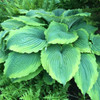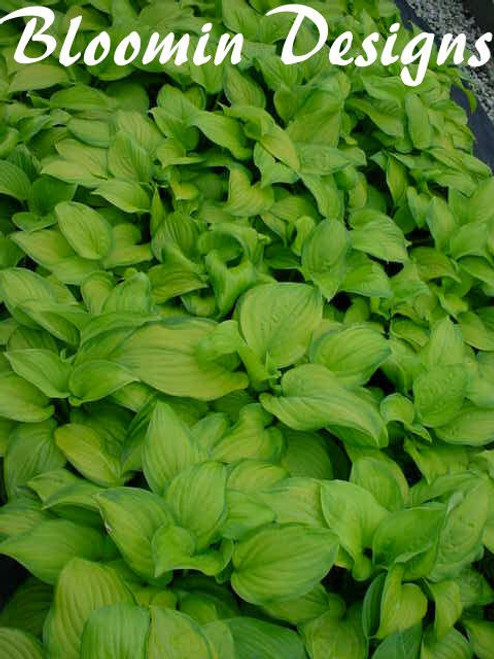Product Description
Hosta 'Spartacus' (25) Bare Root Plants
Common Name: Hosta
This green-centered sport of 'Sea Gulf Stream' has deeply veined leaves that form a dome-like shape with heavily rippled yellow margins. Pale lavender flowers in early to midsummer.
Hostas are exceedingly popular perennials in today's gardens due to their versatility in the landscape. Their subtle colors, tall flower scapes, and broad, coarse leaves fill a niche in garden designs that few other plants can achieve. Their large leaves provide excellent coverage for dying bulb foliage. Hostas also grow well in city environments where the air may be polluted by car exhaust, etc.
Hostas grow best in moist, well-drained, highly organic soils with a pH between 5.5 and 7.5. Sandy loam is better than clay because it provides more aeration for the roots. High-filtered or dappled sunlight is necessary for clean, healthy growth. Morning sun is tolerable and will help to intensify the leaf colors, but hot afternoon sun is usually deadly to hostas. They are most at home in shady, woodland settings and often work well as specimen or edging plants.
Especially in northern zones, hostas should be mulched with a layer of finely shredded organic material to prevent heaving in the winter. Mulch is beneficial because it retains moisture around the plant's roots, but it is also the ideal place for slugs to hide. Watch for holes in the center of the leaves. If they are present, so are slugs. Applying a slug bait in early spring when new shoots are beginning to emerge will help to reduce the slug population. After a few years when plants are firmly established, the mulch can be removed completely, which should eliminate the slug problem altogether. Also be sure to clean all hosta foliage out of the garden in early winter after the plants have gone dormant. By doing so, you will be ridding the area of the eggs of slugs and other leaf-eating insects.
American Hosta Society Benedict Garden Performance Award Honorable Mention -- 2018
American Hosta Society Benedict Garden Performance Award of Merit -- 2019
Height: 17.0 Inches
Spread: 36.0 Inches
Scape Height: 36.0 Inches
Hardiness Zones: 3,4,5,6,7,8,9
Flower Color: Purple shades
Foliage Color: Green shades, Variegated
Part Shade to Full Shade
Average to Consistent Water Needs
Average to Fertile Soil Quality
Bloomtime: Early Summer, Midsummer
Attracts Hummingbirds
Growth Rate: Medium
Border Plant, Cut Foliage, Easy To Grow, Attractive Foliage, Specimen, Focal Point
Hosta 'Spartacus' is a captivating hosta cultivar that stands out with its vibrant, variegated foliage and unique dome-like shape. It is a sport of Hosta 'Sea Gulf Stream', but with a distinct personality of its own. Here is a closer look at what makes 'Spartacus' so special:
Appearance:
- Leaves: The leaves are the main attraction of 'Spartacus'. They are heart-shaped, deeply veined, and a rich, mid-green color. What sets them apart is the bright, golden-yellow margin that surrounds each leaf, creating a striking contrast. The margins are also heavily rippled, adding a playful touch to the overall appearance. The leaves are slightly reverse-cupped, contributing to the plant's distinctive mounded form.
- Size: 'Spartacus' is a large hosta, typically growing to about 20-24 inches tall and 48 inches wide. This makes it a substantial presence in the garden, perfect for filling in space or creating a bold statement.
- Flowers: In mid-summer, 'Spartacus' produces pale lavender flowers on tall, arching scapes that reach about 32 inches in height. The flowers are charming, but the main attraction is definitely the foliage.
Growing Information:
- Light: Like most hostas, 'Spartacus' prefers part shade to full shade. It can tolerate some morning sun, but it is best to avoid hot afternoon sun, which can scorch the leaves.
- Soil: It thrives in moist, well-drained soil that is rich in organic matter. Adding compost or well-rotted manure to the planting hole will help to improve soil fertility and drainage.
- Watering: Keep the soil consistently moist, especially during dry spells. However, avoid overwatering, which can lead to root rot.
- Hardiness: 'Spartacus' is hardy in USDA zones 3-9, making it suitable for a wide range of climates.
Other Notable Features:
- Unique Shape: The reverse-cupped leaves create a distinctive dome-like shape that sets 'Spartacus' apart from other hostas.
- Bright Variegation: The bright, golden-yellow margins provide a beautiful contrast against the green centers, making this hosta a real eye-catcher.
- Vigorous Growth: It is a vigorous grower that will quickly form a nice clump.
Uses in the Garden:
- Shade Gardens: It is a perfect addition to any shade garden, where its unique foliage can add color and texture.
- Woodland Gardens: It blends beautifully with other shade-loving plants in a woodland setting.
- Specimen Plant: Its striking foliage and unique shape make it a great specimen plant, drawing the eye and adding a touch of drama to the garden.
- Groundcover: It can also be used as a groundcover in shady areas, providing excellent coverage and suppressing weeds.
Additional Tips:
- Protect from slugs and snails, which can damage the leaves.
- Divide clumps every few years to maintain vigor and prevent overcrowding.
- Remove any dead or damaged leaves to keep the plant looking its best.
Hosta 'Spartacus' is a truly captivating hosta that is sure to become a favorite in your shade garden. Its unique shape, bright variegation, and vigorous growth make it a standout choice for any hosta enthusiast.
Other Details
The most important part of the plant is its root system. Healthy roots are the foundation of a healthy, vibrant plant. The type of plug container used is based on the specific needs of the plants. Perennials offered as bare root traditionally perform better when planted as bare root.Planted in a specialized mix, potted plants have well established root systems. Top growth stage will vary depending on the current life cycle and time of year when shipped. In Winter and early Spring dormant plants may be shipped. Dormant plants may be planted right away, even before the last frost date.
Most bare root varieties are field grown for at least one season, though Hemerocallis and Hosta are grown for two seasons. The bulk of the soil is removed during the harvesting process and the tops of most varieties are trimmed back to the crown. They are graded, packed in shredded aspen or sphagnum moss and stored in freezers until ready to be shipped.
See our Container Sizes and Bare Root Perennials pages for more information.
Plant information and care is provided in the Overview section, Plant Genus Page and general information is provided in the Planting Care & Guides. Additional questions can be asked on each Plant page.
Plant Spacing: Using the maximum mature spread or width of a plant to guide spacing, ensures space to grow to full size. To fill an area sooner, plant them closer together. Just remember, future thinning or transplanting may be needed.
Water: Keep a close eye on newly planted perennials, especially throughout the first growing year. Most early plant loss is due to too much or too little water!








